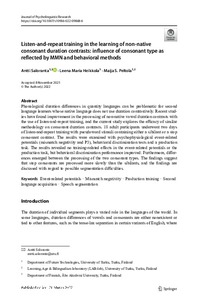Listen-and-repeat training in the learning of non-native consonant duration contrasts: influence of consonant type as reflected by MMN and behavioral methods
Saloranta Antti; Heikkola Leena Maria; Peltola Maija S.
https://urn.fi/URN:NBN:fi-fe2022081154747
Tiivistelmä
Phonological duration differences in quantity languages can be problematic for second language learners whose native language does not use duration contrastively. Recent studies have found improvement in the processing of non-native vowel duration contrasts with the use of listen-and-repeat training, and the current study explores the efficacy of similar methodology on consonant duration contrasts. 18 adult participants underwent two days of listen-and-repeat training with pseudoword stimuli containing either a sibilant or a stop consonant contrast. The results were examined with psychophysiological event-related potentials (mismatch negativity and P3), behavioral discrimination tests and a production task. The results revealed no training-related effects in the event-related potentials or the production task, but behavioral discrimination performance improved. Furthermore, differences emerged between the processing of the two consonant types. The findings suggest that stop consonants are processed more slowly than the sibilants, and the findings are discussed with regard to possible segmentation difficulties.
Kokoelmat
- Rinnakkaistallenteet [27094]
